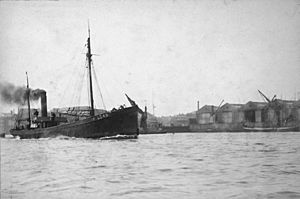SM UB-107 facts for kids
Quick facts for kids History |
|
|---|---|
| Name | UB-107 |
| Ordered | 23 September 1916 |
| Builder | Blohm & Voss, Hamburg |
| Cost | 3,714,000 German Papiermark |
| Yard number | 313 |
| Launched | 21 July 1917 |
| Commissioned | 16 February 1918 |
| Fate | sunk 27 July 1918 by British warships at 54°23′N 0°24′W / 54.383°N 0.400°W. |
| General characteristics | |
| Class and type | German Type UB III submarine |
| Displacement |
|
| Length | 55.30 m (181 ft 5 in) (o/a) |
| Beam | 5.80 m (19 ft) |
| Draught | 3.70 m (12 ft 2 in) |
| Propulsion |
|
| Speed |
|
| Range |
|
| Test depth | 50 m (160 ft) |
| Complement | 3 officers, 31 men |
| Armament |
|
| Service record | |
| Part of: |
|
| Commanders: |
|
| Operations: | 4 patrols |
| Victories: |
|
SM UB-107 was a German Type UB III submarine or U-boat. She served in the German Imperial Navy (called Kaiserliche Marine in German) during World War I. The letters "SM" stand for "Seiner Majestät," which means "His Majesty's" in English. So, "SM UB-107" means "His Majesty's Submarine UB-107."
This submarine was officially put into service on February 16, 1918. During the war, UB-107 went on 4 missions. She managed to sink 11 merchant ships, which weighed a total of 26,147 tons. UB-107 was believed to have been sunk on July 27, 1918, by British warships.
Contents
Building a U-boat: The Story of UB-107
UB-107 was ordered by the German Imperial Navy on September 23, 1916. She was built by a company called Blohm & Voss in Hamburg, Germany. After almost a year of construction, the submarine was launched into the water on July 21, 1917.
Like other Type UB III submarines, UB-107 was designed to carry 10 torpedoes. She also had a powerful deck gun that was about 8.8 centimeters (3.5 inches) wide. The submarine needed a crew of up to 3 officers and 31 sailors to operate.
UB-107 could travel a long distance without needing to refuel, about 7,420 nautical miles (13,742 kilometers). When on the surface, she weighed about 519 tons. When submerged underwater, she weighed 649 tons. Her engines allowed her to travel at 13.3 knots (24.6 kilometers per hour) on the surface and 7.4 knots (13.7 kilometers per hour) underwater.
The Mystery of UB-107's Final Fate
For a long time, it was thought that UB-107 was sunk by depth charges on July 27, 1918. This attack was carried out by the British Royal Navy trawler Calvis and HMY Vanessa II. However, some experts later argued that UB-107 might not have been there. This is because another U-boat, believed to be UB-107, was responsible for sinking two other ships, Chloris and John Rettig, just a few hours later.
In 1985, divers found the wreck of UB-107 about one mile north of Flamborough Head in England. The submarine's wreck was tangled with another ship, the SS Malvina. The Malvina was a British steamship that had been sunk by a torpedo on August 3, 1918.
The UB-107 was identified by special markings on its propellers. It is now thought that UB-107 might have had an accident or hit a British mine sometime between July 28 and August 3, 1918. Sadly, if this is true, all 38 crew members would have been lost.
Ships Sunk or Damaged by UB-107
UB-107 was involved in several attacks on merchant ships during its patrols. Here is a list of the ships she sank or damaged:
| Date | Name | Nationality | Tonnage | Fate |
|---|---|---|---|---|
| 10 May 1918 | Erich Lea | 1,630 | Sunk | |
| 10 May 1918 | Naparima | 1,685 | Damaged | |
| 6 June 1918 | Koningin Regentes | 1,970 | Sunk | |
| 8 June 1918 | Hogarth | 1,231 | Sunk | |
| 13 June 1918 | Agnes | 1,334 | Sunk | |
| 13 June 1918 | Kalo | 1,957 | Sunk | |
| 15 June 1918 | Kieldrecht | 1,284 | Sunk | |
| 8 July 1918 | Chicago | 7,709 | Sunk | |
| 8 July 1918 | War Crocus | 5,296 | Sunk | |
| 9 July 1918 | Fryken | 943 | Sunk | |
| 27 July 1918 | Chloris | 984 | Sunk | |
| 27 July 1918 | John Rettig | 1,809 | Sunk |
UB-107 on TV: A Documentary Mystery
The story of UB-107's sinking was featured in an episode of the TV show Deep Sea Detectives. The episode was titled "Mystery U-Boat of WWI." This documentary looked at different ideas about how the submarine sank. It used both historical records and information from divers who explored the wreck.


